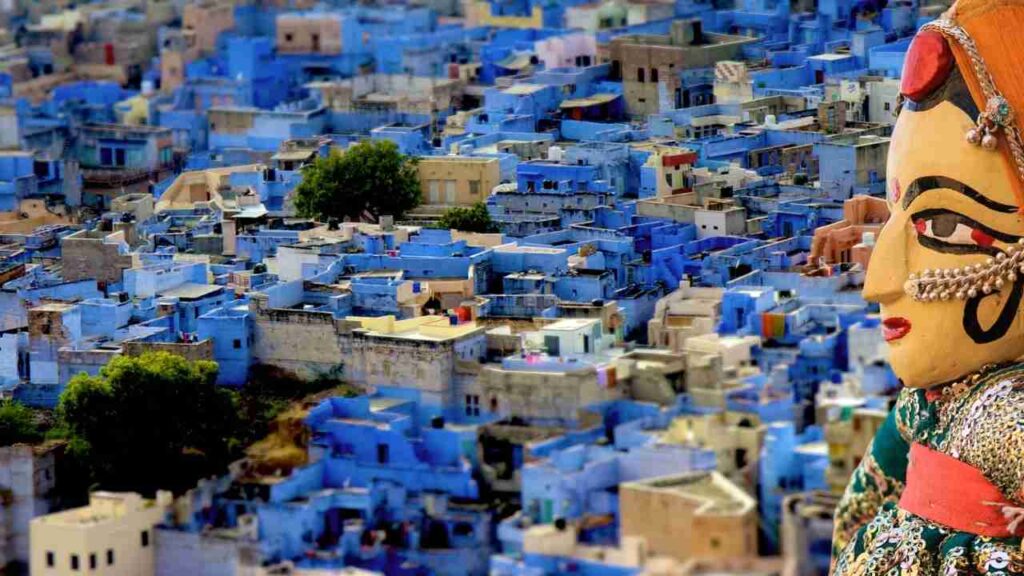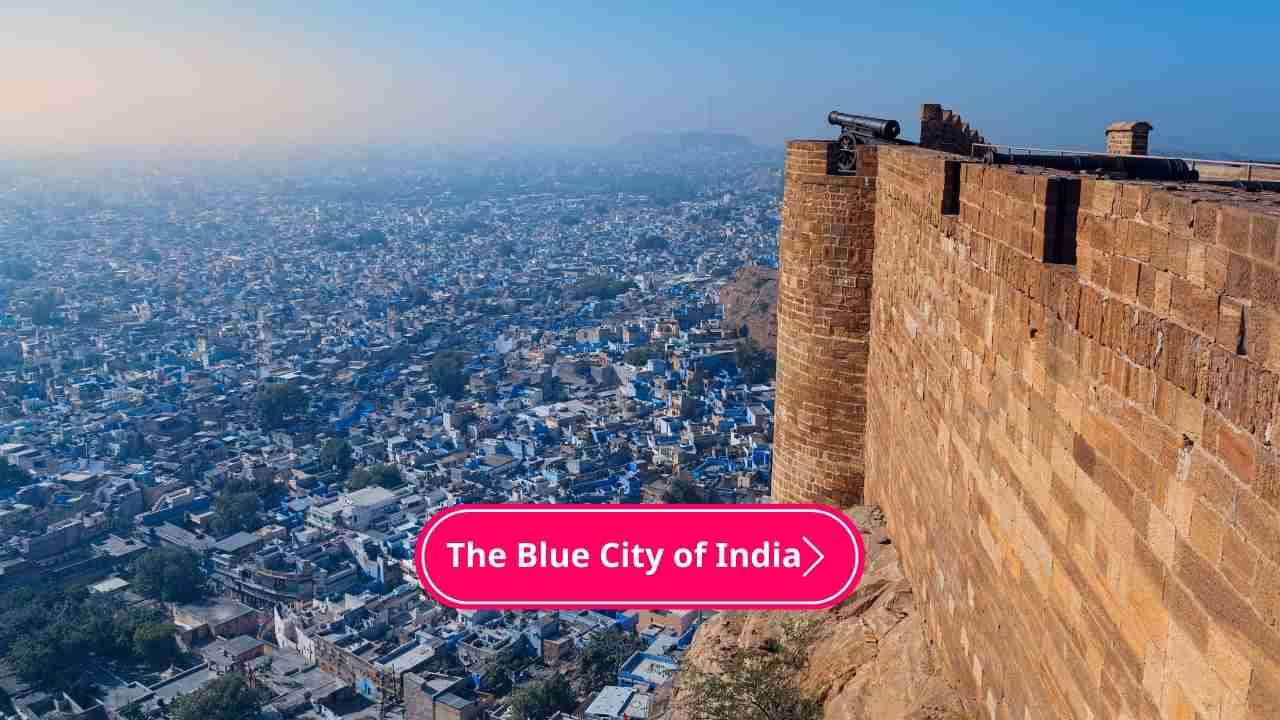The Blue City of India: India is home to a diverse range of cultural and architectural wonders, and one city stands out for its mesmerizing color and historical significance. Jodhpur, famously known as the “Blue City of India.” Located in the heart of Rajasthan, Jodhpur is where history, culture, and stunning visuals blend perfectly, offering a unique and enchanting experience.
Why is Jodhpur Called the ‘The Blue City of India’?
Jodhpur’s distinctive feature is its blue-colored houses, making it an iconic destination and earning it the “Blue City.” When the sun sets, the blue-painted walls of the city shine even more brightly, creating a dazzling effect that seems to come straight out of a dream. The view of the city during sunset is nothing short of magical, with the blue walls glowing under the golden light of the setting sun, giving it a surreal, almost otherworldly, atmosphere.
But the story behind this city’s blue walls goes beyond just its visual appeal. The blue color is rooted in both history and tradition, making it a significant cultural symbol of the city.
Before Taj Mahal, this daughter built ‘mini’ Taj Mahal for her father
The History Behind Jodhpur’s Blue Walls ‘The Blue City of India’
The tradition of painting houses blue in Jodhpur dates back to the Brahmin community. It is said that the Brahmins, a prominent caste in the city, began painting their homes blue to distinguish themselves from the other castes. Over time, this tradition spread to the entire city. Today, the blue color is not confined to just one street or neighborhood; rather, it is a defining characteristic of the whole city.
Jodhpur, located in the desert region of Rajasthan, experiences intense heat during much of the year. One of the reasons for the widespread use of blue paint was that it is believed that the color helps reflect the sun’s rays, keeping the houses cooler in the extreme heat. This practical aspect of blue-colored homes became especially important in a city where the temperatures can soar above 40°C (104°F) in the summer months. The blue walls help maintain a cooler, more comfortable living space during the harsh desert heat.

Additionally, there is a belief that the blue color also keeps mosquitoes and other insects at bay. In a city where these insects are a common problem, this belief added another layer of practicality to the tradition of painting homes blue.
The color blue is also tied to royalty and regality in Rajasthan, where it is often associated with the royal family. Jodhpur itself has long been a center of royal power and influence, and the blue color helps add to the regal feel of the city. As a result, the blue-painted homes also serve as a visual representation of Jodhpur’s royal heritage.
Best 4 Places to Visit in The ‘Blue City of India’
Jodhpur is much more than just its blue-painted houses. The city is rich in history, culture, and architecture, making it a must-visit destination for anyone interested in exploring the grandeur of Rajasthan. Here are some of the top places you should visit when in Jodhpur:
Mehrangarh Fort
One of the most famous and impressive forts in India, Mehrangarh Fort is a must-see landmark in Jodhpur. Perched high on a hill, this historic fort offers stunning views of the entire city below. Built in the 15th century by Rao Jodha, the founder of Jodhpur, the fort is an architectural marvel. Its massive walls, intricate carvings, and royal interiors showcase the grandeur of Rajasthan’s royal history. You can explore various sections of the fort, including museums that display artifacts, paintings, and armor from the royal era.
Umaid Bhawan Palace
Another gem in Jodhpur is the Umaid Bhawan Palace, a magnificent structure that blends art deco and Rajasthani architectural styles. Built in the early 20th century, it is one of the largest private residences in the world. Today, the palace is partly a luxury hotel, and part of it has been turned into a museum. The palace is famous for its grand architecture, beautiful gardens, and spectacular views of the surrounding landscape.
Mandore Gardens
For those who want to explore Jodhpur’s historical side in a more peaceful setting, Mandore Gardens is a must-visit. Located around 9 km from the city center, this garden complex is home to temples, cenotaphs, and royal tombs of the Marwar rulers. The gardens are lush and green, providing a contrast to the arid landscape surrounding the city. The beautiful architecture and serene atmosphere make this a perfect spot for history lovers and those who want to escape the hustle and bustle of the city.
Sadar Bazaar
If you’re looking to experience the vibrant culture of Jodhpur and pick up some traditional Rajasthani souvenirs, a visit to Sadar Bazaar is essential. This bustling market is the best place to buy handicrafts, clothing, spices, jewelry, and other local goods. The market is also a great place to immerse yourself in the colors and sounds of Jodhpur. Be sure to try some local Rajasthani food from the street vendors while you’re there.
Other Interesting Facts About Jodhpur
Cultural Hub: Jodhpur is also a center of Rajasthani culture, with numerous festivals, fairs, and events happening throughout the year. The city is particularly famous for its traditional music and dance performances, which are often seen during the annual Marwar Festival.
Local Cuisine: Jodhpur is a paradise for food lovers. Don’t miss out on trying traditional Rajasthani dishes like dal baati churma, gatte ki sabzi, and mirchi vada. For dessert, try the famous mohanthal and gulab jamun.
Cultural Significance: Jodhpur is often referred to as the “Gateway to Thar,” as it serves as the entry point to the Thar Desert, which is one of the largest deserts in India. The city’s proximity to the desert adds to its unique desert charm and influences its culture, lifestyle, and architecture.
The Magic of Sunset in Jodhpur: One of the most enchanting experiences you can have in Jodhpur is watching the sunset from Mehrangarh Fort. As the sun begins to set, the blue walls of the city come alive with an even brighter hue. The golden rays of the setting sun reflect off the blue-painted houses, creating a mesmerizing effect. From the fort’s ramparts, the entire city below looks like a vast ocean of blue, with the golden hues of sunset adding a magical touch to the scene. The sight is breathtaking, and it is considered one of the most beautiful views in all of India.
Conclusion
Jodhpur, the Blue City of India, is a place that offers an incredible mix of history, culture, architecture, and natural beauty. From its blue-painted houses to its magnificent forts and royal palaces, Jodhpur is a living testament to Rajasthan’s rich heritage. Whether you are walking through its narrow streets, shopping in its colorful markets, or watching the sunset over the blue walls of the city, Jodhpur offers an unforgettable experience that will leave you in awe.
If you love exploring cities with a deep cultural heritage, stunning architecture, and beautiful landscapes, Jodhpur should definitely be on your travel list. The combination of the blue cityscape, royal history, and warm hospitality makes Jodhpur one of the most unique and enchanting destinations in India.

